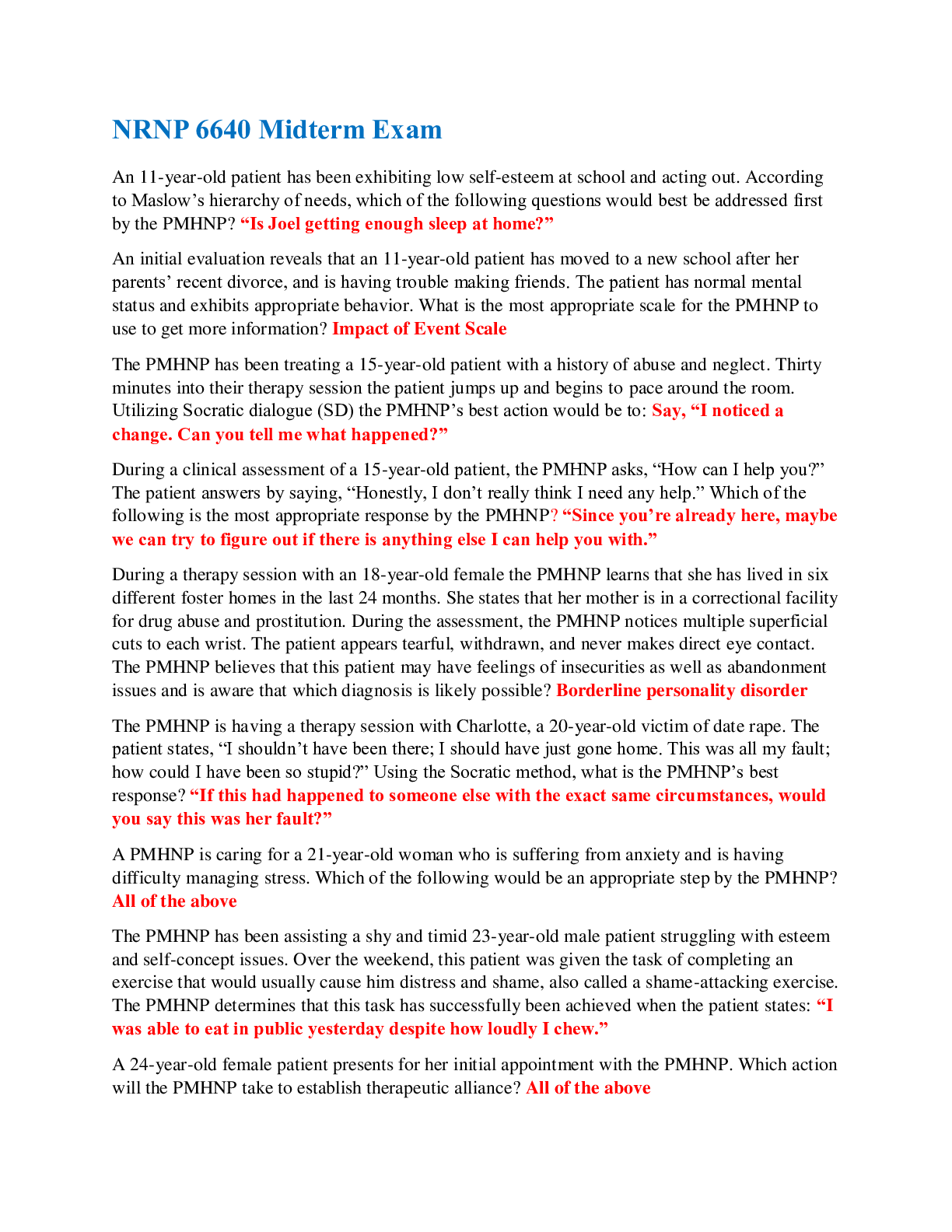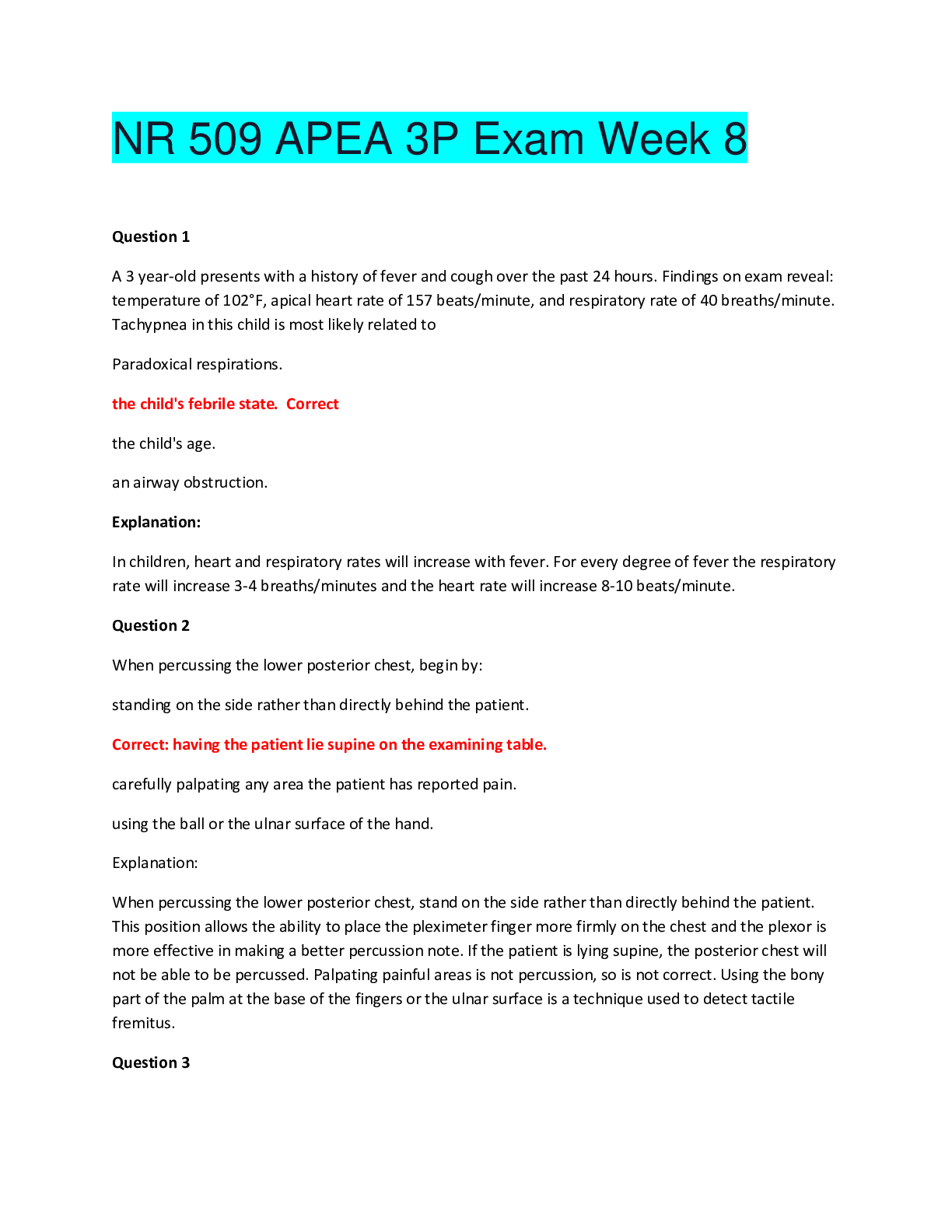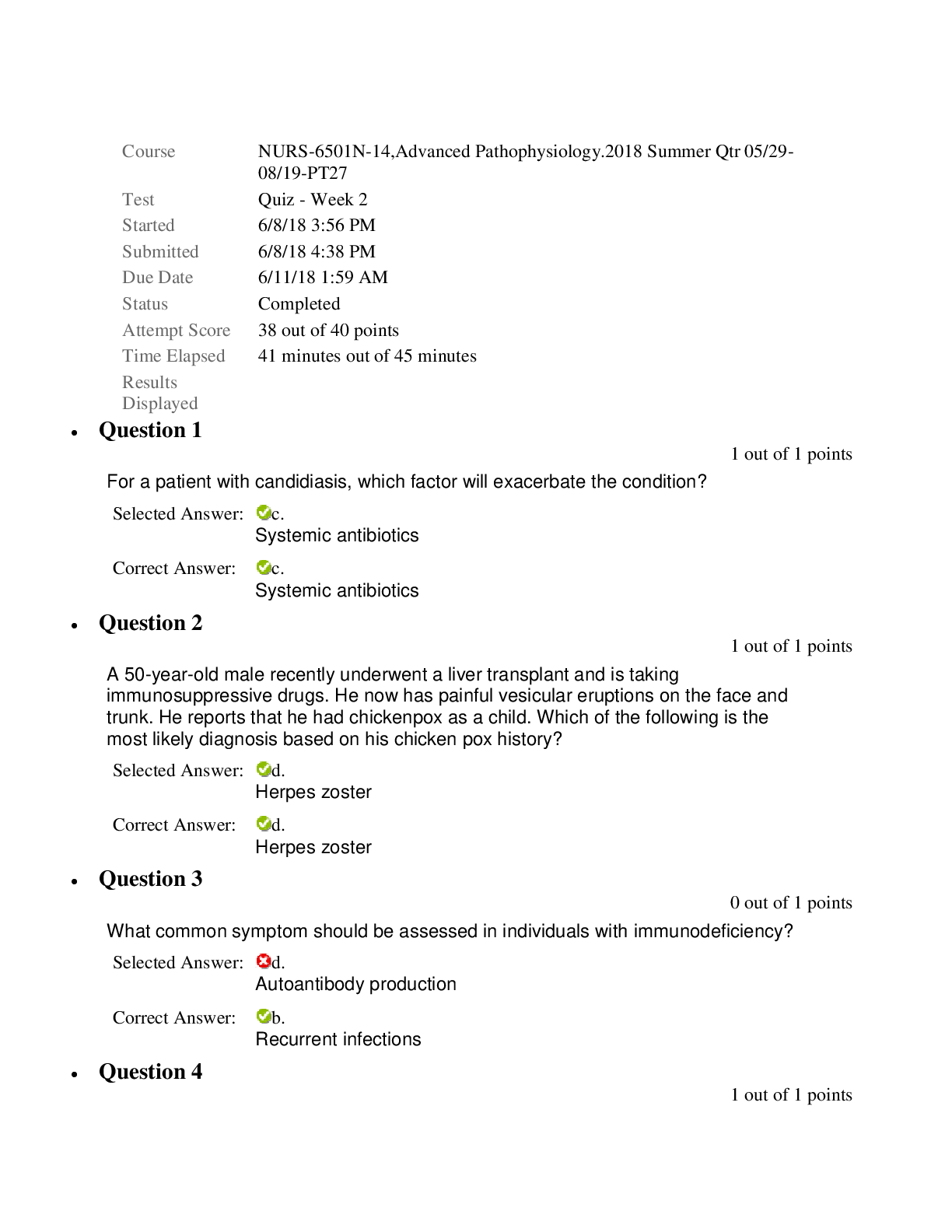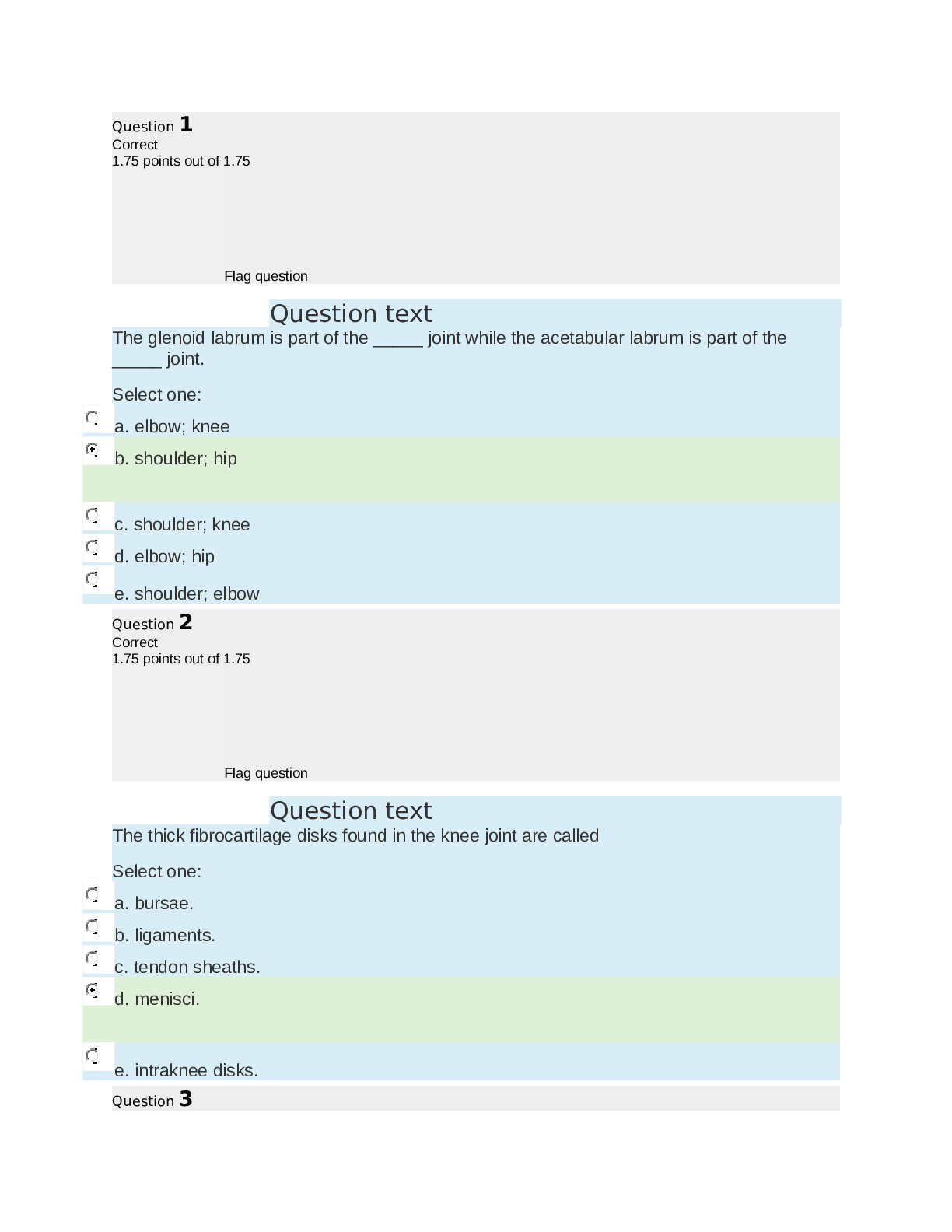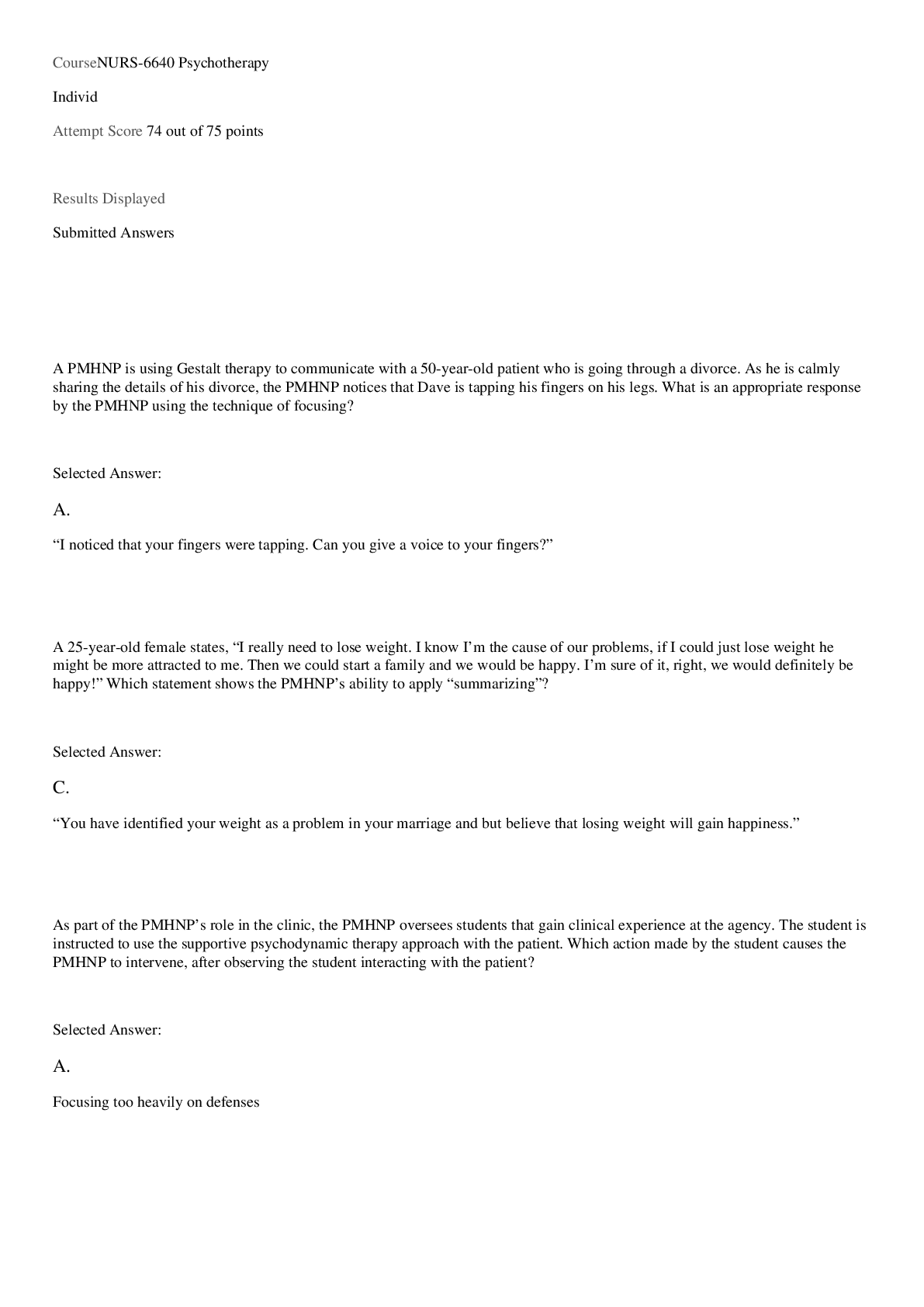Health Care > EXAM > Advanced Health Assessment Exam Questions And Answers All correct (All)
Advanced Health Assessment Exam Questions And Answers All correct
Document Content and Description Below
Advanced Health Assessment Exam Questions And Answers All correct A 59 year old patients tells the nurse practitioner that he thinks he must have ulcerative colitis. He has been having "black stool... s" for the last 24 hours. How would the nurse practitioner best document THE FACTS for his reason for seeking care? A) JM is a 59 year old male here for having "black stools" for the past 24 hours. B) JM came into the clinic complaining of black stools for the past 24 hours. C) JM is a 59 year old male here for "ulcerative colitis." D) JM, a 59 year old male, states he has ulcerative colitis and wants it checked. Correct Answer: A) JM is a 59 year old male here for having "black stools" for the past 24 hours. Chief Complaint(s) The one or more symptoms or concerns causing the patient to seek care. Make every effort to quote the patient's own words. A patient tells the nurse practitioner that she has had abdominal pain for the past week. What would be the best response by the nurse practitioner? A) We'll talk more about that later in the interview." B) "Have you ever had any children?" C) "What have you had to eat in the last 4 hours?" D) "Can you point to where it hurts?" Correct Answer: D) "Can you point to where it hurts?" Each principle symptom should be well-characterized, with descriptions of location; along with the other seven attributes. Location: Ask the patient to point to the pain because lay terms may not be specific enough to localize the site of origin. A 29-year-old woman tells the nurse that she has "excruciating pain" in her back. Which of the following would be an appropriate response by the nurse to her statement? A) "How does your family react to your pain?" B) "That must be terrible. You probably pinched a nerve." C) "I've had back pain myself and it can be excruciating." D) "How would you say the pain affects your ability to do your daily activities?" Correct Answer: D) "How would you say the pain affects your ability to do your daily activities?" Inquire about the effects of pain on the patient's daily activities, mood, sleep, work, and sexual activity. In recording the childhood illnesses of a patient who denies having had any, which of the following notes by the nurse would be most accurate? A) Patient denies usual childhood illnesses. B) Patient states he was a "very healthy" child. C) Patient states sister had measles, but he didn't. D) Patient denies measles, mumps, rubella, chickenpox, pertussis, rheumatic fever, and polio. Correct Answer: D) Patient denies measles, mumps, rubella, chickenpox, pertussis, rheumatic fever, and polio. Childhood illnesses include measles, rubella, mumps, whooping cough, rheumatic fever, scarlet fever, and polio. They are included in the past history. A patient tells the nurse that he is allergic to penicillin. What would be the nurse's best response to this information? A) "Are you allergic to any other drugs?" B) "How often have you received penicillin?" C) "I'll write your allergy on your chart so you won't receive any." D) "Please describe what happens to you when you take penicillin." Correct Answer: D) "Please describe what happens to you when you take penicillin." Allergies, including specific reactions to each medication, such as rash or nausea, must be recorded. The nurse is taking a family history. Important diseases or problems to ask the patient about include: A) emphysema. B) head trauma. C) mental illness. D) fractured bones. Correct Answer: C) mental illness. Specifically ask for any family history of heart disease, high blood pressure, stroke, diabetes, obesity, blood disorders, ovarian cancer, colon cancer, sickle cell anemia, arthritis, allergies, alcohol or drug addiction, mental illness, suicide, seizure disorder, kidney disease, and tuberculosis. The other answers are acquired. The following information is recorded in the health history: "Patient denies chest pain, palpitations, orthopnea, and paroxysmal nocturnal dyspnea." Which category does it belong to? A) Chief complaint B) Present illness C) Personal and social history D) Review of systems Correct Answer: D) Review of systems Most review of systems questions pertain to systems. You may also draw on Review of Systems questions related to the Chief Complaint to establish positives and negatives that help clarify the diagnosis. Which of the following statements represents subjective data obtained from the patient regarding his skin? A) Skin appears dry. B) No obvious lesions C) Denies color change D) Lesion noted lateral aspect right arm Correct Answer: C) Denies color change Remember that the history (from the chief complaint through review of systems) should be limited to patient statements or subjective data—factors that the person says were or were not present. Subjective data is what the patient tells you. The following information is best placed in which category? "The patient had a stent placed in the left anterior descending artery (LAD) in 1999." A) Medical B) Surgical C) Obstetrics/gynecology D) Psychiatric Correct Answer: B) Surgical Provide information relative to Adult Illnesses in each of four areas: Medical, Surgical, Obstetric/Gynecologic, and Psychiatric. During the aging process, the hair can look gray or white and begin to feel thin and fine. The nurse practitioner knows that this occurs because of a decrease in: A) pigmentation B) thyroid stimulating hormone C) phagocytes D) fungacytes Correct Answer: A) pigmentation Hair undergoes a series of changes. Scalp hair loses its pigment (functioning of melanocytes) so the hair looks gray or white and feels thin and fine. The other options are not correct. You are speaking to an 8th grade class about health prevention and are preparing to discuss the ABCDEs of melanoma. Which of the following descriptions correctly defines the ABCDEs? A) A = actinic; B = basal cell; C = color changes, especially blue; D = diameter >6 mm; E = evolution B) A = asymmetry; B = irregular borders; C = color changes, especially blue; D = diameter >6 mm; E = evolution C) A = actinic; B = irregular borders; C = keratoses; D = dystrophic nails; E = evolution D) A = asymmetry; B = regular borders; C = color changes, especially orange; D = diameter >6 mm; E = evolution Correct Answer: B) A = asymmetry; B = irregular borders; C = color changes, especially blue; D = diameter >6 mm; E = evolution You are examining the skin on a 22 year old female when you notice a circumscribed superficial lesion that is elevated approximately 0.5cm in diameter, filled with serous fluid. What type of lesion is this? A) macule B) papule C) vesicle D) spider angioma Correct Answer: C) vesicle Vesicle - up to 1.0 cm filled with serous fluid A 72-year-old teacher comes to a skilled nursing facility for rehabilitation after being in the hospital for 6 weeks. She was treated for sepsis and respiratory failure and had to be on a ventilator for 3 weeks. The nurse is completing an initial assessment and evaluating the client's skin condition. On her sacrum there is full-thickness skin loss that is 5 cm in diameter with damage to the subcutaneous tissue. The underlying muscle is not affected. What is the stage of this pressure ulcer? A) Stage 1 B) Stage 2 C) Stage 3 D) Stage 4 Correct Answer: C) Stage 3 A crater appears in the skin, with full-thickness skin loss and damage to or necrosis of subcutaneous tissue that may extend to, but not through underlying muscle. Mrs. Anderson presents with an itchy rash which is raised and appears and disappears in various locations. Each lesion lasts for many minutes. What most likely accounts for this rash? A) Insect bites B) Wheals, urticaria, or hives C) Psoriasis D) Purpura Correct Answer: B) Wheals, urticaria, or hives Wheals/urticaria - a somewhat irregular, relatively transient, superficial area of localized skin edema. Ethel is a 68 year old Caucasian female who is new to your area. She shows you multiple brown colored, flat lesions on her face, chest, and hands that have been present for years. You respond that these are likely: A) solar lentigos B) melanomas C) keloids D) fissures Correct Answer: A) solar lentigos solar lentigos are from sun damage, are more common on the face, shoulders, and hands. A 27 year old female patient has three furuncles connected around a hair follicle. You use the following term in your charting: A) nodules B) carbuncle C) macules D) bulla Correct Answer: B) carbuncle Multiple furuncles around a hair follicle form a carbuncle. A young man comes to you with an extremely pruritic rash over his knees and elbows which has come and gone for several years. It seems to be worse in the winter and improves with some sun exposure. On examination, you notice scabbing and crusting with some silvery scale, and you are observant enough to notice small "pits" in his nails. What would account for these findings? A) Eczema B) Pityriasis rosea C) Psoriasis D) Tinea infection Correct Answer: C) Psoriasis Psoriasis: silvery scaly papules or plaques, mainly on the extensor surfaces. Pitting: punctate depressions of the nail plate caused by defective layering of the superficial nail plate by the proximal nail matrix. Usually associated with psoriasis. Suzanne, a 25 year old, comes to your clinic to establish care. You are the student preparing to go into the examination room to interview her. Which of the following is the most logical sequence for the patient-provider interview? A) Establish the agenda, negotiate a plan, establish rapport, and invite the patient's story. B) Invite the patient's story, negotiate a plan, establish the agenda, and establish rapport. C) Greet the patient, establish rapport, invite the patient's story, establish the agenda, expand and clarify the patient's story, and negotiate a plan. D) Negotiate a plan, establish an agenda, invite the patient's story, and establish rapport. Correct Answer: C) Greet the patient, establish rapport, invite the patient's story, establish the agenda, expand and clarify the patient's story, and negotiate a plan. The sequence of the interview: Greeting the patient and establishing rapport. Taking notes. Establishing the agenda for the interview. Inviting the patient's story. Expanding and clarifying the patient's story. Sharing the treatment plan. A young woman undergoes cranial nerve testing. On touching the soft palate, her uvula deviates to the left. Which of the following is likely? A) CN IX lesion on the left B) CN X lesion on the left C) CN IX lesion on the right D) CN X lesion on the right Correct Answer: D) CN X lesion on the right In cranial nerve X paralysis, the soft palate fails to rise and the uvula deviates to the opposite side. When performing posterior palpation of the thyroid gland, you should do all fo the following, EXCEPT: A) Have the patient tip his or her head forward and slightly to the side. B) Place your index fingers above the cricoid cartilage. C) Palpate between the sternocleidomastoid muscle and the trachea for the lobes of the thyroid. D) Move your fingers laterally to palpate for the thyroid lobes. Correct Answer: B) Place your index fingers above the cricoid cartilage. Place the fingers of both hands on the patient's neck so that your index fingers are just BELOW the cricoid cartilage. You are interviewing an elderly woman in the ambulatory setting and trying to get more information about her urinary symptoms. Which of the following techniques is NOT a component of guided questioning? A) Reassuring the patient that the urinary symptoms are benign and that she doesn't need to worry about it being a sign of cancer. B) Offering the patient multiple choices in order to clarify the character of the urinary symptoms she is experiencing. C) Asking her to tell you what she means when she states that she has a urinary tract infection. D) Directed questioning starting with the general and proceeding to the specific in a manner that does not make the patient give a yes/no answer. Correct Answer: A) Reassuring the patient that the urinary symptoms are benign and that she doesn't need to worry about it being a sign of cancer. Bates p 59, 69-71 Mrs. T. comes for her regular visit to the clinic. She is on your schedule because her regular provider is on vacation and she wanted to be seen. You have heard about her many times from your colleague and are aware that she is a very talkative person. Which of the following is a helpful technique to improve the quality of the interview for both the provider and the patient? A) Allow the patient to speak uninterrupted for the duration of the appointment. B) Briefly summarize what you heard from the patient in the first 5 minutes and then try to have her focus on one aspect of what she told you. C) Set the time limit at the beginning of the interview and stick with it, no matter what occurs in the course of the interview. D) Allow your impatience to show so that the patient picks up on your nonverbal cue that the appointment needs to end. Correct Answer: B) Briefly summarize what you heard from the patient in the first 5 minutes and then try to have her focus on one aspect of what she told you. Give the patient free rein for the first 5-10 minutes, listening closely to the conversation. Focus on what seems most important to the patient. Learn to set limits when needed. A brief summary may help you change the subject yet validate any concerns. Do no show your impatience. Which of the following will help to optimize success from a pediatric examination? A) Doing the examination out of order if necessary to take advantage of quiet periods for auscultation, etc. B) Being very orderly, so as not to miss a portion of the examination. C) Using firmness throughout your examination, letting the child know you are in charge. D) Making sure to place the infant on the table during the examination while Mom watches close by. Correct Answer: A) Doing the examination out of order if necessary to take advantage of quiet periods for auscultation, etc. With certain exceptions, physical examination does not require use of the examining table, or with the child in a parent's lap. Plan the examination to start with the least distressing procedures and end with the most distressing, usually involving the throat and ears. Patience, distraction, play flexibility in the order of the examination, and caring but firm approach are all key to successfully examining the young child. A patient has come in for an examination and states, "I have this spot in front of my ear lobe here on my cheek that seems to be getting bigger and is tender. What do you think it is?" The NP notes swelling above the angle of the jaw and suspects it could be an inflammation of his: A) occipital node B) thyroid gland C) parotid gland D) none of the above Correct Answer: C) parotid gland The swelling of the parotid gland is seen anterior to the ear lobes and above the angles of the jaw. All of the following are a common or concerning symptom in a health history for a respiratory assessment EXCEPT? A) palpitations B) blood-streaked sputum C) chest pain D) snoring Correct Answer: A) palpitations Chest pain, blood-streaked sputum, and snoring are all common or concerning symptoms in a health history for respiratory assessment. A 29-year-old physical therapist presents for evaluation of an eyelid problem. On observation, the right eyeball appears to be protruding forward. Based on this description, what is the most likely diagnosis? A) Epicanthus B) Ptosis C) Exophthalmos D) Ectropion Correct Answer: C) Exophthalmos Eye protrusion (proptosis or exophthalmos) The nurse practitioner is performing an eye examination using the ophthalmoscope. Which component is NOT part of the ophthalmoscope? A) lens disc B) aperature C) indicator of diopters D) speculum Correct Answer: D) speculum See picture of ophthalmoscope (Bates p 238) A 15-year-old high school soph [Show More]
Last updated: 1 year ago
Preview 1 out of 29 pages
Instant download
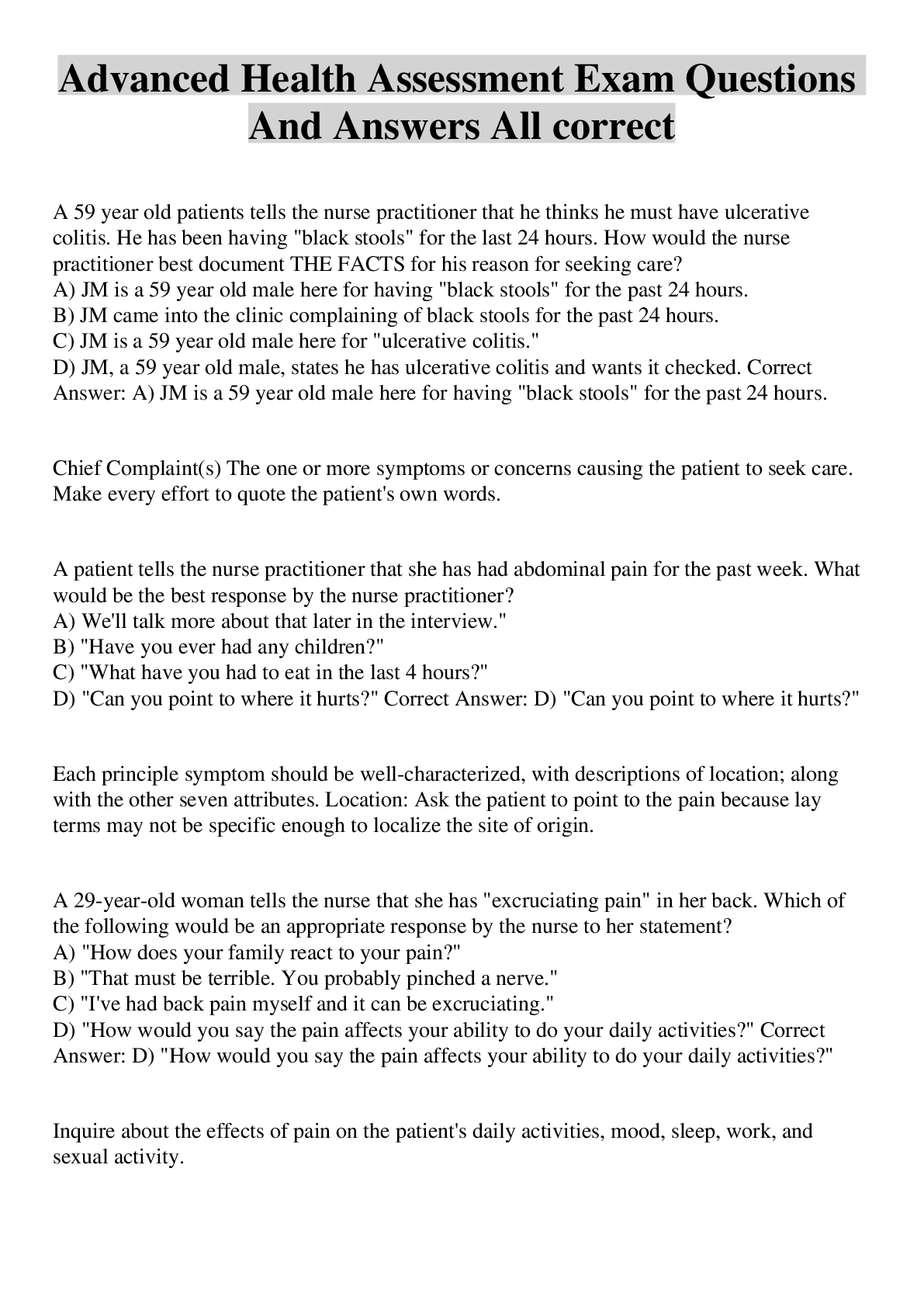
Buy this document to get the full access instantly
Instant Download Access after purchase
Add to cartInstant download
Reviews( 0 )
Document information
Connected school, study & course
About the document
Uploaded On
Sep 19, 2022
Number of pages
29
Written in
Additional information
This document has been written for:
Uploaded
Sep 19, 2022
Downloads
0
Views
170




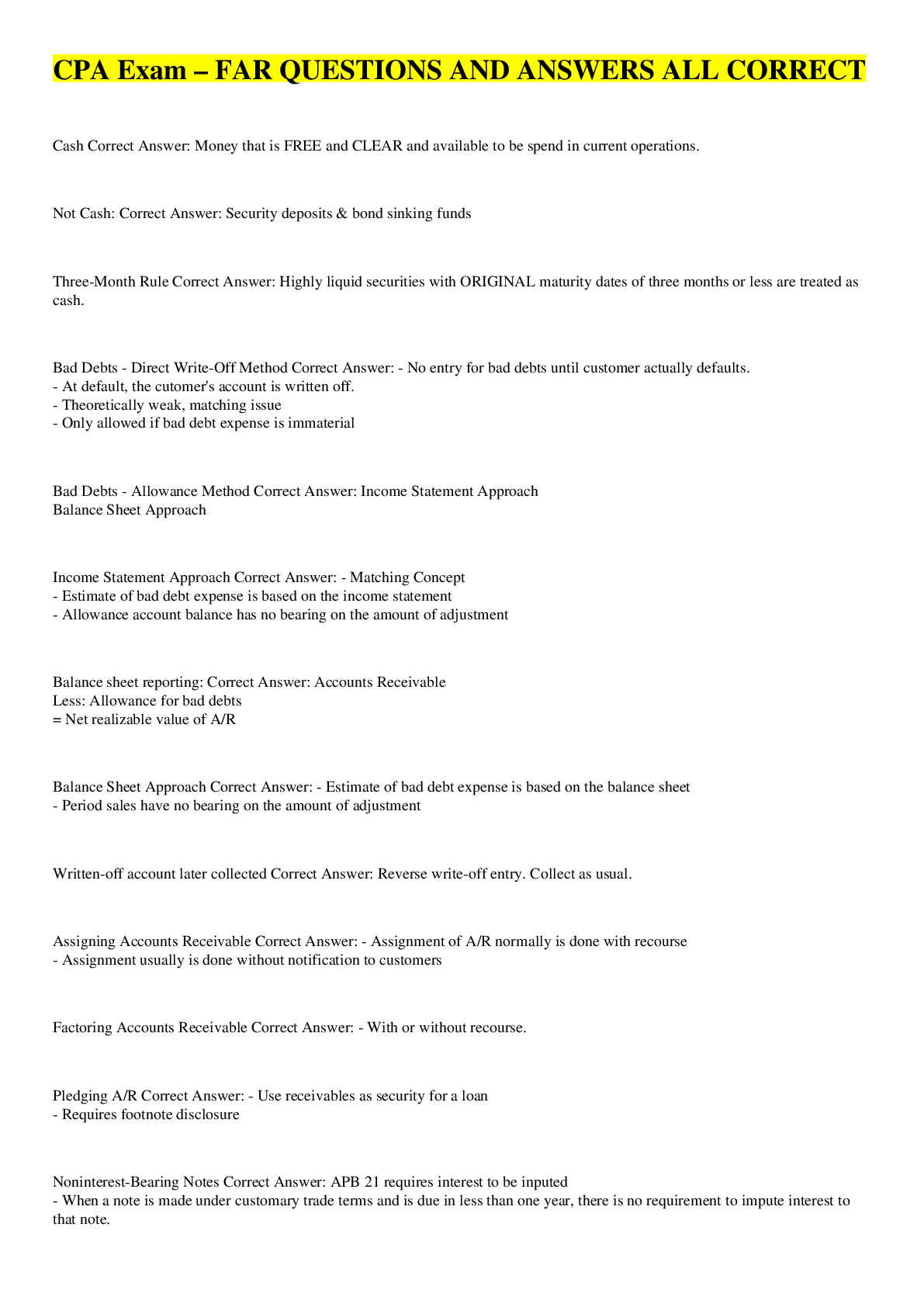
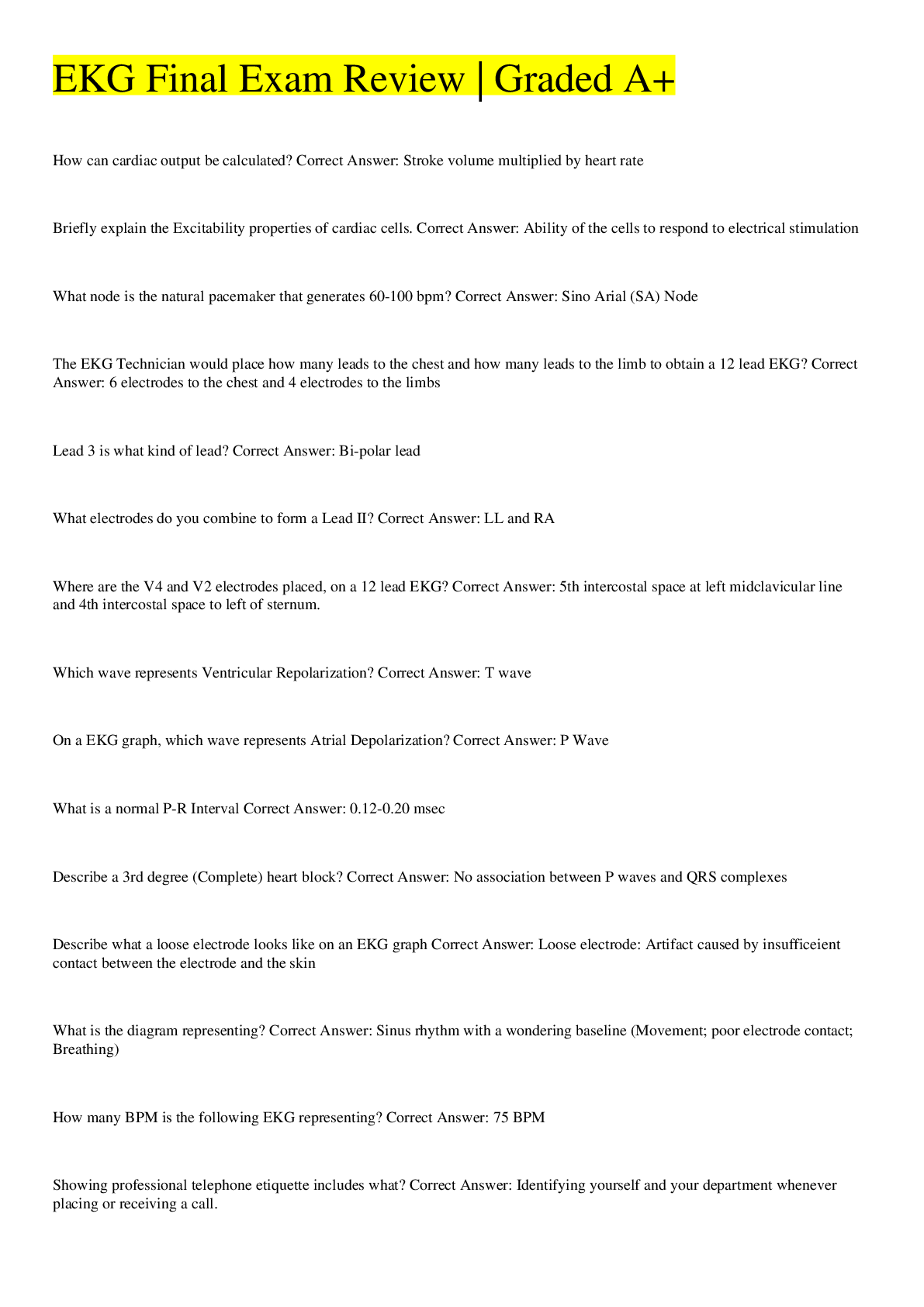

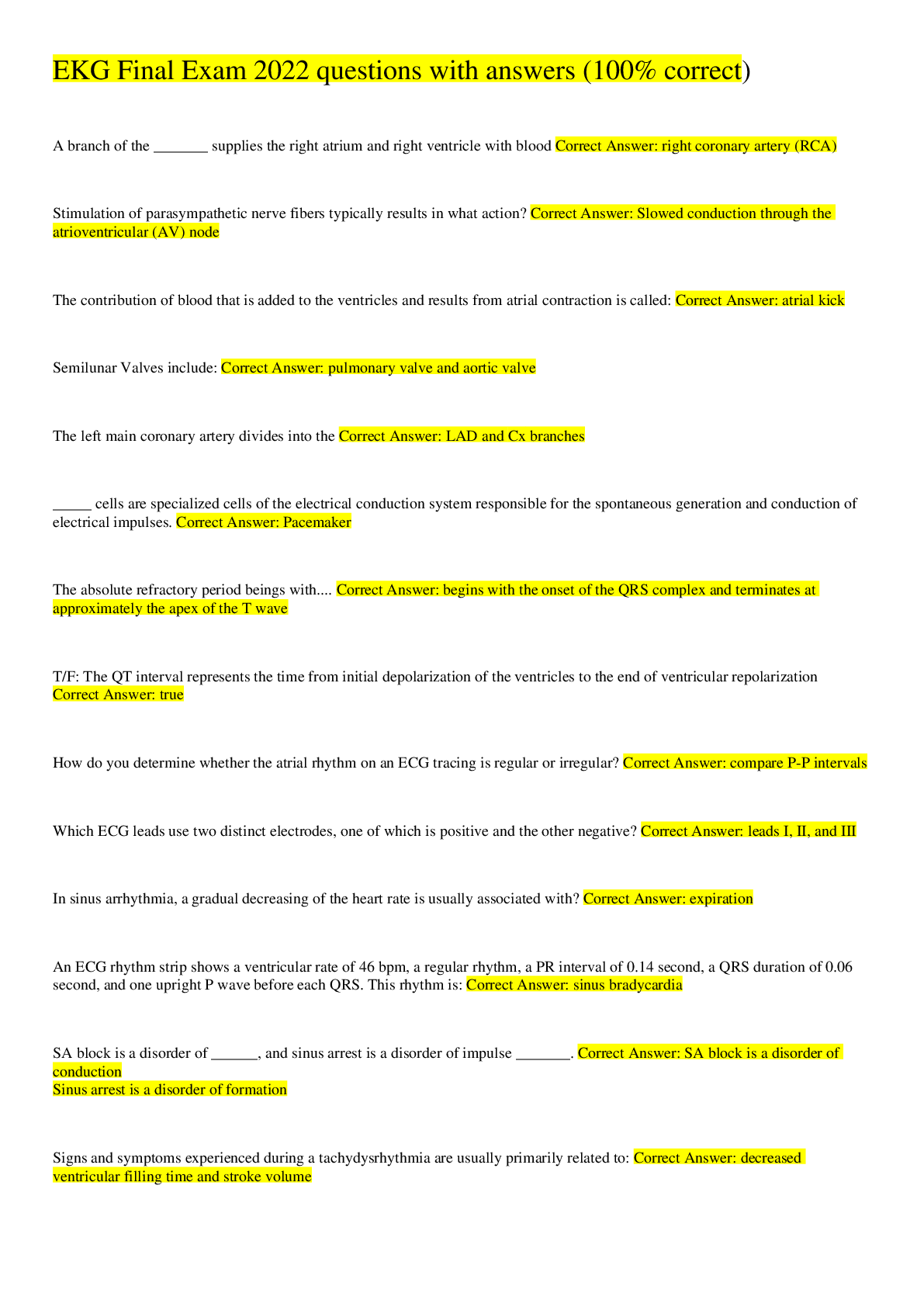
.png)
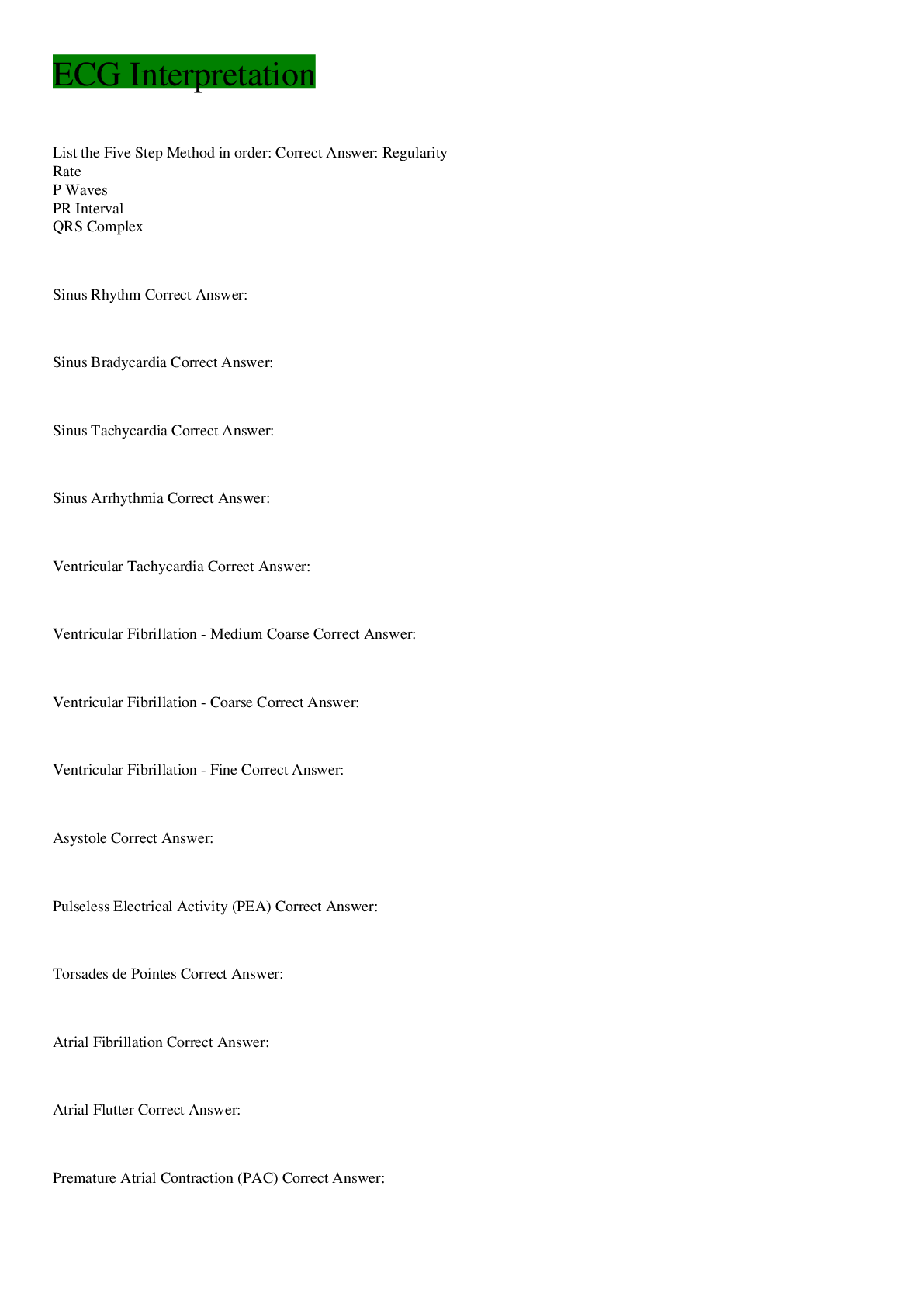
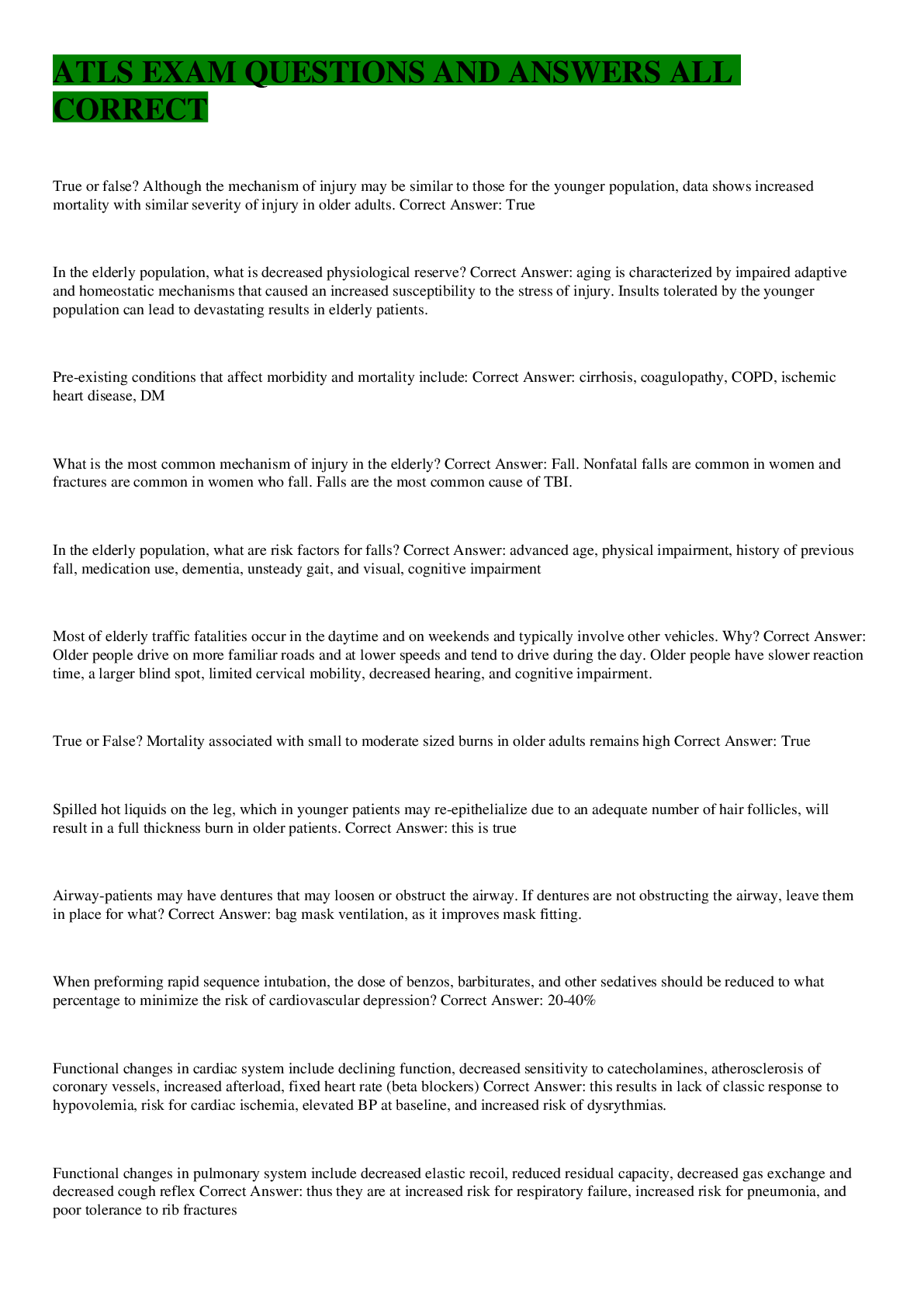
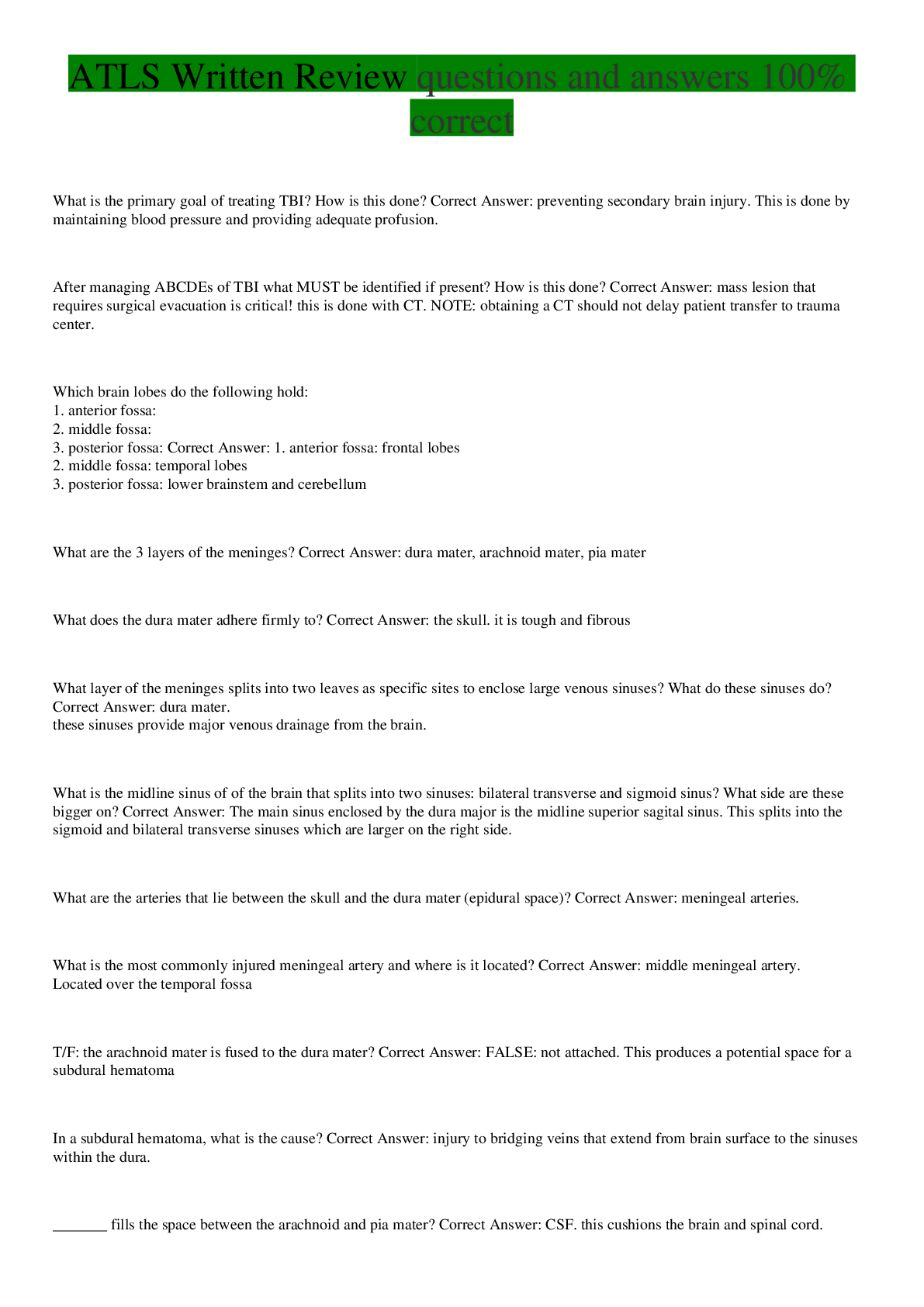

.png)


